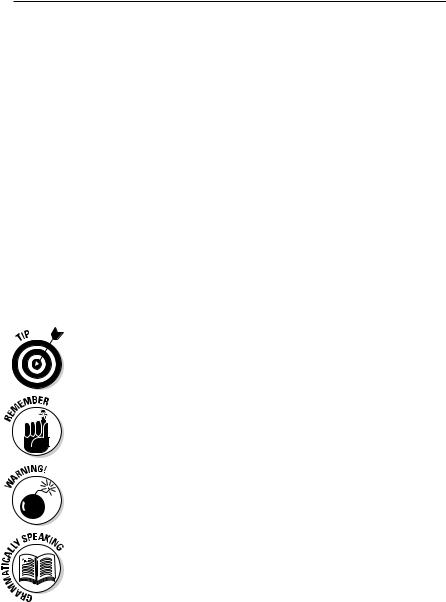
- •About the Authors
- •Dedication
- •Acknowledgments
- •Table of Contents
- •Introduction
- •About This Book
- •Conventions Used in This Book
- •Foolish Assumptions
- •How This Book Is Organized
- •Icons Used in This Book
- •Where to Go from Here
- •The French You’re Familiar With
- •Idioms and Popular Expressions
- •Key Parts of Speech
- •Cavorting with Verbs
- •Forming Sentences and Questions
- •The French Alphabet
- •Uttering Vowel and Consonant Sounds
- •Greetings: Formal and Friendly
- •Asking Questions to Get to Know People
- •Counting Your Lucky Stars: Numbers
- •Using the Calendar and Dates
- •Telling Time in French
- •Discussing Where You Live with the Verb “Habiter”
- •Discussing Daily Routine with Reflexive Verbs
- •Using Possessive Adjectives to Introduce Your Family Members
- •Basic Questions and Polite Expressions
- •Stating Your Preferences
- •Talking about Your Livelihood
- •Chatting about the Weather
- •Deciding to Keep in Touch
- •Getting Direction about Directions
- •Dining Out
- •Going to the Market
- •Going Shopping
- •Going Out with the Verb “Sortir”
- •Having Fun with the Verb “S’amuser”
- •Oh, the Places You’ll Go!
- •Making Plans with Friends
- •Making a Phone Call
- •Livin’ in the Past: Using the Past Tense
- •Playing Sports and Games
- •Going to the Beach
- •Setting Up Camp
- •Enjoying Quieter Pursuits
- •Where Do You Want to Go?
- •Getting Ready for Your Trip
- •Getting Current with Currency
- •Going to the Bank
- •Using Credit Cards and ATMs
- •Getting through the Airport
- •Navigating Buses, Trains, and Subways
- •Getting Around by Car
- •Finding Accommodations
- •Checking In to a Hotel
- •Checking Out of a Hotel
- •Getting Help Fast
- •Getting Medical Help
- •Handling Legal Matters
- •Label the Things in Your House
- •Write Your Shopping Lists in French
- •Listen to French Music
- •Watch French Movies
- •Tune in to TV5
- •Read French Publications
- •Take a Class
- •Join a French Association
- •Join an Online Chat or Pen Pal Forum
- •Using “Tu” When You Mean “Vous”
- •Using “Bonne nuit!” for Good-Bye
- •Using “Garçon” or “Porteur” to Address Service Staff
- •Saying “Je suis excité(e)” to Indicate Excitement
- •Saying “Je suis chaud(e)/froid(e)” to Say You’re Hot or Cold
- •Saying “Je suis plein/e” to Mean You’re Full
- •Using “de la glace” to Request Ice
- •Using “Je suis . . . ans” to Tell Your Age
- •Asking for Change with “J’ai besoin de change”
- •Using the Verb “Visiter” in Reference to People
- •“À mon avis”
- •“C’est pas vrai”
- •“Avec plaisir”
- •“C’est génial”
- •“À votre santé”
- •“À vos souhaits”
- •“Quelle horreur!”
- •“À bientôt”
- •“Passez-moi un coup de fil!”
- •“On y va!” or “Allons-y!”
- •“Je n’en sais rien”
- •“Je n’en reviens pas”
- •“Ça vaut la peine”
- •“C’est pas grave”
- •“N’importe”
- •“Tu cherches midi à 14h”
- •“Prenons un pot!”
- •Regular French Verbs
- •Auxiliary French Verbs
- •Track Listing
- •Customer Care
- •Index

Introduction 5
Part V: Appendixes
This part of the book includes important information that you can use for reference. Appendix A is a mini-dictionary in both French-to-English and English- to-French formats. If you encounter a French word that you don’t understand or you need to say something in French that you can’t find quickly elsewhere in the book, you can look it up here. Appendix B features verb tables, which show you how to conjugate regular verbs and then how to conjugate those verbs that stubbornly don’t fit the pattern. Appendix C gives you the answer keys to all of the Fun & Games activities that appear in the book, and Appendix D lists the tracks that appear on the audio CD that comes with this book so that you can find the dialogues easily and follow along.
Icons Used in This Book
You may be looking for particular information while reading this book. To make certain types of information easier to find, we’ve placed the following icons in the left-hand margins throughout the book:
This icon highlights tips that can make learning French easier.
This icon points out interesting information that you ought not forget.
To help you avoid linguistic, grammatical, and cultural faux pas, we use this icon.
Languages are full of quirks that may trip you up if you’re not prepared for them. This icon points to discussions of these peculiar grammar rules.
www.ATIBOOK.ir

6French For Dummies, 2nd Edition
If you’re looking for information and advice about culture and travel, look for this icon. It draws your attention to interesting tidbits about the countries in which French is spoken.
The audio CD that comes with this book gives you the opportunity to listen to real French speakers so that you can get a better understanding of what French sounds like. This icon marks the Talkin’ the Talk dialogues that you can find on the CD.
Where to Go from Here
Learning a language is all about jumping in and giving it a try (no matter how bad your pronunciation is at first). So make the leap! Start at the beginning, pick a chapter that interests you, or listen to a few dialogues on the CD. Before long, you’ll be able to respond Oui! (wee!) (Yes!) when people ask Parlez-vous français? (pahr-ley vooh frahN-seh?) (Do you speak French?).
Note: If you’ve never been exposed to French before, you may want to read the chapters in Part I before you tackle the later chapters. Part I gives you some of the basics that you need to know about the language, such as how to pronounce the various sounds, some basic expressions and words, and the fundamentals of French sentence structure.
www.ATIBOOK.ir

Part I
Getting Started
www.ATIBOOK.ir

You have to start somewhere, but we bet that you know a lot more French than you think. Don’t think
so? Then check out Chapter 1 and see how many French words and idioms you already use. Chapters 2 and 3 provide some basic background on French grammar and pronunciation, while Chapters 4 and 5 get you talking about yourself and your family. So get started and don’t worry — We make it fun!
www.ATIBOOK.ir
